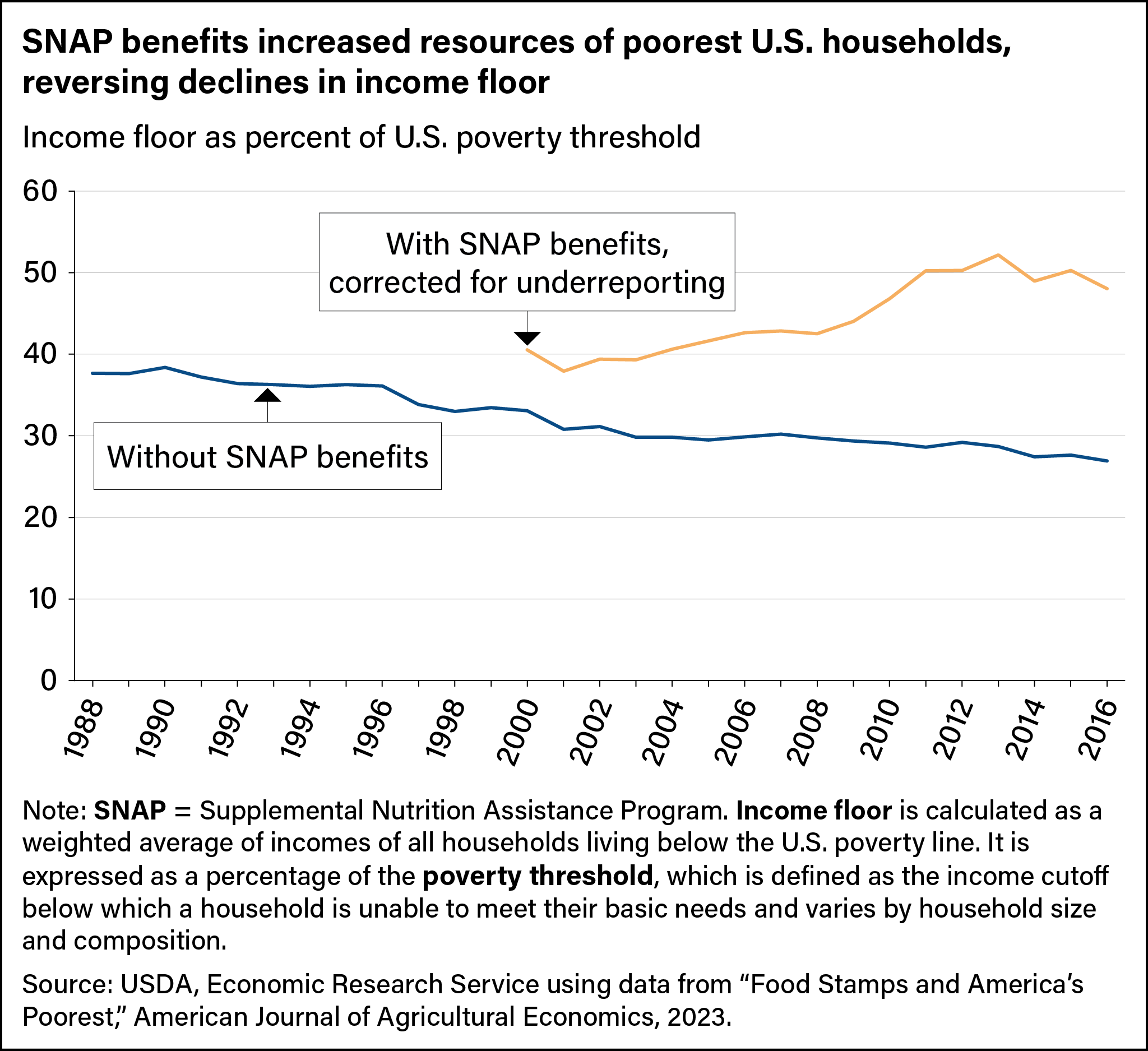
New Metric Gauges How Much SNAP Benefits Support Lowest-Income Households
- by Laura Tiehen, Dean Jolliffe and Juan Margitic
- 4/4/2024
The Supplemental Nutrition Assistance Program (SNAP) is the cornerstone of USDA’s food assistance programs. On average, 42.1 million people participated in the program each month in fiscal year 2023. Participants received an average monthly benefit of $212 per person, making SNAP a significant contributor to their household budgets. SNAP is available to most households with limited incomes and assets and designed to provide larger benefits to poorer households.
Researchers at USDA, Economic Research Service, the World Bank, and Georgetown University examined SNAP’s effectiveness at improving the well-being of the poorest U.S. households by raising their income levels. To accomplish this, the researchers developed a measure—the income floor— to represent the income level of the poorest household in a society. It may seem straightforward to use the lowest value of household income reported in a nationally representative survey as the measure of the income floor. However, there are pitfalls to using the minimum reported income level in household survey data to represent the income floor in a population. For example, households may not be able to accurately report their earnings, especially if they have jobs that are sporadic or informal. Therefore, rather than being based on the income level of a single household, the income floor is calculated as a weighted average of the incomes of all households living below the poverty line. To best estimate the lowest household income level, the weighted average gives increasingly more weight to households as their incomes approach the lowest reported income in the data.
Using the U.S. Census Bureau’s Current Population Survey, the researchers first estimated the income floor using data on income as defined for the official U.S. poverty measure, which does not include SNAP benefits. They then estimated the income floor with the value of SNAP benefits included. While SNAP benefits increase the resources of all participating households, the income floor measure is designed to focus on changes in the resources of the poorest households. Comparing the income floor with and without SNAP benefits shows how much SNAP increases the resources of the poorest households. To get a more accurate estimate of the effect of SNAP benefits on the income floor, the researchers corrected for the underreporting of SNAP benefits in household surveys.
During the 2000–16 period, SNAP benefits, corrected for underreporting, increased the income floor an annual average of more than 50 percent, the researchers found. SNAP had a larger impact during the Great Recession (December 2007–June 2009) and its aftermath, when the SNAP caseload increased and stimulus legislation in 2008 boosted benefits. From 2011 to 2016, SNAP increased the income floor an annual average of more than 75 percent. Adding the value of SNAP benefits to household income reversed the decline in the income floor that would have occurred without the program, especially during the period after the Great Recession.
The income floor measure can complement existing poverty measures to assess need and understand the consequences of SNAP and other assistance programs on the well-being of the country’s poorest households. The income floor is particularly well-suited to measure progress assistance programs make toward reducing financial difficulties for the poorest of the poor.
This article is drawn from:
- Jolliffe, D., Margitic, J., Ravallion, M. & Tiehen, L. (2023). Food stamps and America’s poorest. American Journal of Agricultural Economics. https://doi.org/10.1111/ajae.12426.
You may also like:
- Farm Bill. (n.d.). U.S. Department of Agriculture, Economic Research Service.
- Toossi, S. & Jones, J.W. (2023). The Food and Nutrition Assistance Landscape: Fiscal Year 2022 Annual Report. U.S. Department of Agriculture, Economic Research Service. EIB-255.
- Oliveira, V., Prell, M., Tiehen, L. & Smallwood, D. (2018). Design Issues in USDA's Supplemental Nutrition Assistance Program: Looking Ahead by Looking Back. U.S. Department of Agriculture, Economic Research Service. ERR-243.


